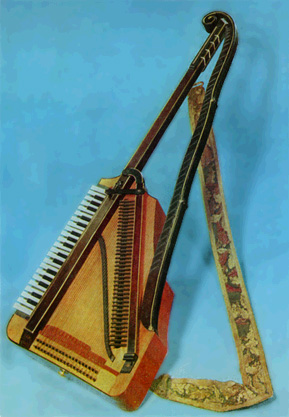The orphica

Orphica, Joseph Dohnal after Carl Leopold Röllig
Vienna c1810; Halle, Händelhaus
A true curio indeed was this sort of piano for "hiking tours". Even carried with the strap over the shoulder or over the lap at rest the limited sound quality and small compass could not inspire any longer-lasting enthusiasm about this sort of portable piano.
music sample:
(excerpt) W.A. Mozart, Adagio C-Dur, KV 617a (356)
played by Li Stadelmann
Instrument: Orphica, probably Joseph Dohnal after Carl Leopold Röllig
The orphica was designed to be carried by the strap. A typical idea of early romanticism in the spirit of walking stick flutes and violins to be used like them in pleasant countryside.
Invented in 1795 by Carl Leopold Röllig, to be followed by lessons and songs with orphica accompaniment edited in the following year. afterwards followed by a keyed harmonica and a bowed keyboard instrument („Xänorphika“ 1801) Röllig showed not only inventor's but also economic talents since he did not build any buThe orphica was a piano of sold licences for production.
The orphica was a piano of about three and a half octaves in compass with single strings. The sound, however was far from convincing, the small body could hardly give more volume than a clavichord and the reduced compass did not allow playing piano music at a time when the piano compass was slowly growing to six octaves.
The charm of such "hiking instruments" encouraged a number of special instrument models in reduced shapes or to be particularly dissembled to be transported in a rucksack easily while walking. Röllig's orphica as a "hiking piano" remained unique. Its shape, however, might have inspired some recent designs for stage keyboards - again with a shoulder strap.
© Greifenberger Institut für Musikinstrumentenkunde | info@greifenberger-institut.de



